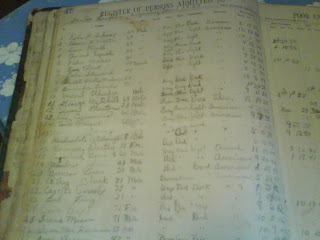Following is the article that was published in "History Pulaski County Missouri, Volume II"
Pulaski County Farm
The “Poor Farm” was owned by Pulaski County. Purchased in the 1800's it was consisted, originally, of some 100 acres of land. It was established for the care of those in the county who were not mentally, physically, or financially able to care for themselves. Times were hard and many people were destitute. Some were feeble-minded. Some were old and weak and senile. Some were crippled physically. Some were blind, and some deaf. Occasionally an abandoned child would be taken in. One young girl was taken in to relieve a bad moral situation. A few children were taken from their parents and placed there because of neglect. A lot of the resident's were just old and couldn't care for themselves and had no folks to help them.
The place was located about a mile up on the Roubidoux River above Waynesville. It was farmland. Had several large buildings; a large residents home, a home for the caretaker and his family and shelter for the farm animals. Large fields and a garden plot.
A “pitcher pump” on a concrete floor supplied their water. A “pitcher pump” is the kind you pump with a long handle, but first you had to prime it with water that had (Hopefully) been left in a pitcher nearby. If someone neglected to leave sufficient water in the pitcher for priming, there was a problem.
Until the latest years all laundry was done on a washboard. The water for washing must be pumped, carried out into the yard and emptied into a large iron kettle with afire under it. The laundry was placed in the hot water, then rubbed with good strong soap, vigorously scrubbed on the washboard (a backbreaking job) wrung out by hand again and hung on the clothesline outdoors to dry. That was just the first part- next they had to be repaired, and then almost everything had to be ironed. Sometimes the caretakers wife had a hired girl but mostly she did the washing and ironing all by herself.
That's not all! She also had the cooking of three meals everyday, the cleaning of all the houses, and the caring for all the residents. I don't know what she got paid but I know whatever it was was not enough!
The man of the family was usually outside farming.
From conversations with people who knew about the County Farm, it must have been a labor of love. Everyone who knew these old folks seemed to be very attached to them, and to have loved them very dearly. It has been my happy experience to hear some of the stories about those good old folks. One old gentleman thought he could tell fortunes and always had a prediction for anyone who asked. Children often went there and took candy, nuts, cakes, and cookies. Even though they enjoyed the goodies, they loved the presence of the children even more. The caretakers wife bought large bolts of material and made all the clothing the old folks wore. This was a good time too. The old ones always had lots of stories to tell and they told them over and over again. Some had dreams of someday living somewhere else. “Aunt Teen” always said she wanted to buried at Flea Holler near Swedeborg. It was done. Alma and Bert Williams were good neighbors to the Farm. She always came to help when someone was sick and if one passed away she always had a short service for them by reading from the Word and singing.
There is a large cemetery on the grounds where there are about 100 people buried. Even though there are few markers on the graves, there is one who knows where they are.
I'm not certain of the date the Farm was disbanded but the land was divided up and sold in 1947.
I have been able to establish that these are at least some of the caretakers; Mr. and Mrs. J.H. Burchard, John J. York, Alice and Barton Sparks, Myrtle and Harry Martin, Nannie and Frank Long, Mr. and Mrs. George Sanders, John and Lola Ichord, James and Gladys Laughlin, Elmer and Gladys Carter, and Fred and Ruby York. There were, no doubt, others, but records are not available.
These are a few of the people I have been able to find lived there: Christa Skaggs, Julina Cobert, Lee Adams, Oma Labarga, Thomas Page, Taylor Curtis, John Williams, Lulu Eaton, Thomas Jones, Grandpa and Grandma Admire, Cap Peal, Calvin H. Stroup, Rebecca Ellen Stroup, Sarah Bryant, William, Hendershot, Hezekiah Pummel, Mary Curley, Mr. and Mrs, Ballard, Mr. Rickerson, Bill Malone, Lola Wagner, Edmond Lynch, Jay Scapps, Johnny Moles, Richard McCullogh, John McCullogh, Mr. Zumwalt, Mr. Buehl, Aunt “Teen”, a lady named Effie, and another named Ida (a school teacher).
There were ever so many more. The people I talked with about this said they could remember these old folks so well. How they looked and some of the things they said and done, but could not remember all their names.
Several people helped with this article, and I am grateful to them all.
Submitted by
Adlyn Shelden Willits

















